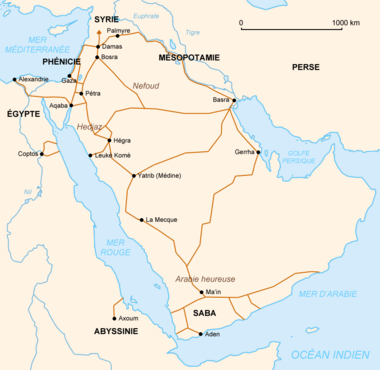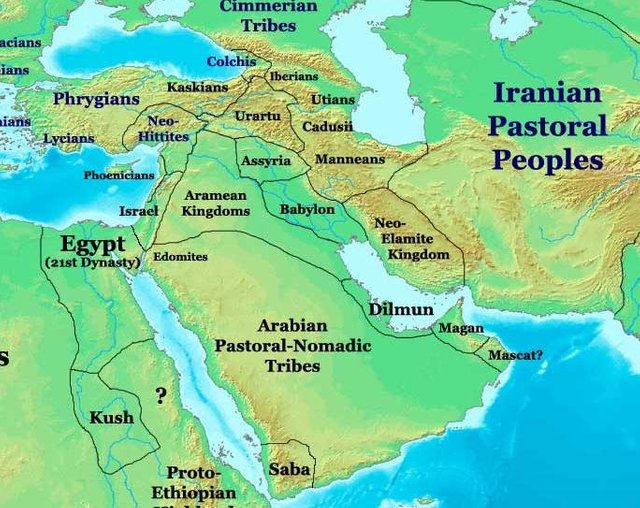History Science of Pre-Islamic Arabia ~ Part 1
Some of the settled communities developed into distinctive civilizations, and are limited to archaeological evidence, accounts written outside of Arabia and Arab oral traditions later recorded by Islamic scholars. Among the most prominent civilizations were the Thamud which arose around 3000 BCE and lasted to about 300 CE and Dilmun which arose around the end of the fourth millennium and lasted to about 600 CE. Additionally, from the beginning of the first millennium BCE, Southern Arabia was the home to a number of kingdoms such as the Sabaeans and the coastal areas of Eastern Arabia were controlled by the Iranian Parthians and Sassanians from 300 BCE.

Studies
Scientific studies of Pre-Islamic Arabs starts with the Arabists of the early 19th century when they managed to decipher epigraphic Old South Arabian (10th century BCE), Ancient North Arabian (6th century BCE) and other writings of pre-Islamic Arabia. Thus, studies are no longer limited to the written traditions, which are not local due to the lack of surviving Arab historians' accounts of that era; the paucity of material is compensated for by written sources from other cultures (such as Egyptians, Greeks, Romans, etc.), so it was not known in great detail. From the 3rd century CE, Arabian history becomes more tangible with the rise of the Ḥimyarite, and with the appearance of the Qaḥṭānites in the Levant and the gradual assimilation of the Nabataeans by the Qaḥṭānites in the early centuries CE, a pattern of expansion exceeded in the explosive Muslim conquests of the 7th century. Sources of history include archaeological evidence, foreign accounts and oral traditions later recorded by Islamic scholars—especially in the pre-Islamic poems—and the Ḥadīth, plus a number of ancient Arab documents that survived into medieval times when portions of them were cited or recorded. Archaeological exploration in the Arabian Peninsula has been sparse but fruitful; and many ancient sites have been identified by modern excavations. The most recent detailed study of pre-Islamic Arabia is Arabs and Empires Before Islam, published by Oxford University Press in 2015. This book collects a diverse range of ancient texts and inscriptions for the history of the region during this time period.
Prehistoric to Iron Age
- Ubaid period (5300 BCE) - could have originated in Eastern Arabia.
- Umm an-Nar Culture (2600–2000 BCE)
- Sabr culture (2000 BCE)
Magan, Midian, and ʿĀd
- Magan is attested as the name of a trading partner of the Sumerians. It is often assumed to have been located in Oman.
- The A'adids established themselves in South Arabia (modern-day Yemen), settling to the east of the Qahtan tribe. They established the Kingdom of ʿĀd around the 10th century BCE to the 3rd century CE.
The ʿĀd nation were known to the Greeks and Egyptians. Claudius Ptolemy's Geographos (2nd century CE) refers to the place by a Hellenized version of the inhabitants of the capital Ubar.
Archaeological evidence suggests that the biblical Midianites were originally a tribe of nomads that came from NW Saudi Arabia before expanding into Jordan and parts of the Arabah valley in Southern Israel.[2][3]
Eastern Arabia
The sedentary people of pre-Islamic Eastern Arabia were mainly Aramaic speakers and to some degree Persian speakers while Syriac functioned as a liturgical language.[4][5] In pre-Islamic times, the population of Eastern Arabia consisted of Christianized Arabs (including Abd al-Qays), Aramean Christians, Persian-speaking Zoroastrians[6] and Jewish agriculturalists.[4][7] According to Robert Bertram Serjeant, the Baharna may be the Arabized "descendants of converts from the original population of Christians (Aramaeans), Jews and ancient Persians (Majus) inhabiting the island and cultivated coastal provinces of Eastern Arabia at the time of the Arab conquest".[7][8]
Zoroastrianism was also present in Eastern Arabia.[9][10][11] The Zoroastrians of Eastern Arabia were known as "Majoos" in pre-Islamic times.[12] The sedentary dialects of Eastern Arabia, including Bahrani Arabic, were influenced by Akkadian, Aramaic and Syriac languages.[13][14]
Dilmun

Dilmun and its neighbors in the 10th century BCE
Image : via wikipedia
The Dilmun civilization was an important trading centre[15] which at the height of its power controlled the Persian Gulf trading routes.[15] The Sumerians regarded Dilmun as holy land.[16] Dilmun is regarded as one of the oldest ancient civilizations in the Middle East.[17][18] The Sumerians described Dilmun as a paradise garden in the Epic of Gilgamesh.[19] The Sumerian tale of the garden paradise of Dilmun may have been an inspiration for the Garden of Eden story.[19] Dilmun appears first in Sumerian cuneiform clay tablets dated to the end of fourth millennium BCE, found in the temple of goddess Inanna, in the city of Uruk. The adjective "Dilmun" is used to describe a type of axe and one specific official; in addition there are lists of rations of wool issued to people connected with Dilmun.[20]
Dilmun was an important trading center from the late fourth millennium to 1800 BCE.[15] At the height of Dilmun's power, Dilmun controlled the Persian Gulf trading routes.[15] Dilmun was very prosperous during the first 300 years of the second millennium.[21] Dilmun's commercial power began to decline between 2000 BCE and 1800 BCE because piracy flourished in the Persian Gulf. In 600 BCE, the Babylonians and later the Persians added Dilmun to their empires.
The Dilmun civilization was the centre of commercial activities linking traditional agriculture of the land with maritime trade between diverse regions as the Indus Valley and Mesopotamia in the early period and China and the Mediterranean in the later period (from the 3rd to the 16th century CE).[18]
Dilmun was mentioned in two letters dated to the reign of Burna-Buriash II (c. 1370 BCE) recovered from Nippur, during the Kassite dynasty of Babylon. These letters were from a provincial official, Ilī-ippašra, in Dilmun to his friend Enlil-kidinni in Mesopotamia. The names referred to are Akkadian. These letters and other documents, hint at an administrative relationship between Dilmun and Babylon at that time. Following the collapse of the Kassite dynasty, Mesopotamian documents make no mention of Dilmun with the exception of Assyrian inscriptions dated to 1250 BCE which proclaimed the Assyrian king to be king of Dilmun and Meluhha. Assyrian inscriptions recorded tribute from Dilmun. There are other Assyrian inscriptions during the first millennium BCE indicating Assyrian sovereignty over Dilmun.[22] Dilmun was also later on controlled by the Kassite dynasty in Mesopotamia.[23]
Dilmun, sometimes described as "the place where the sun rises" and "the Land of the Living", is the scene of some versions of the Sumerian creation myth, and the place where the deified Sumerian hero of the flood, Utnapishtim (Ziusudra), was taken by the gods to live forever. Thorkild Jacobsen's translation of the Eridu Genesis calls it "Mount Dilmun" which he locates as a "faraway, half-mythical place".[24]
Dilmun is also described in the epic story of Enki and Ninhursag as the site at which the Creation occurred. The promise of Enki to Ninhursag, the Earth Mother:
For Dilmun, the land of my lady's heart, I will create long waterways, rivers and canals, whereby water will flow to quench the thirst of all beings and bring abundance to all that lives.
Ninlil, the Sumerian goddess of air and south wind had her home in Dilmun. It is also featured in the Epic of Gilgamesh.
However, in the early epic "Enmerkar and the Lord of Aratta", the main events, which center on Enmerkar's construction of the ziggurats in Uruk and Eridu, are described as taking place in a world "before Dilmun had yet been settled".
Source : https://en.wikipedia.org/wiki/Pre-Islamic_Arabia
wow. your copy-paste skills are on point!
haahahha... sorry buddy.